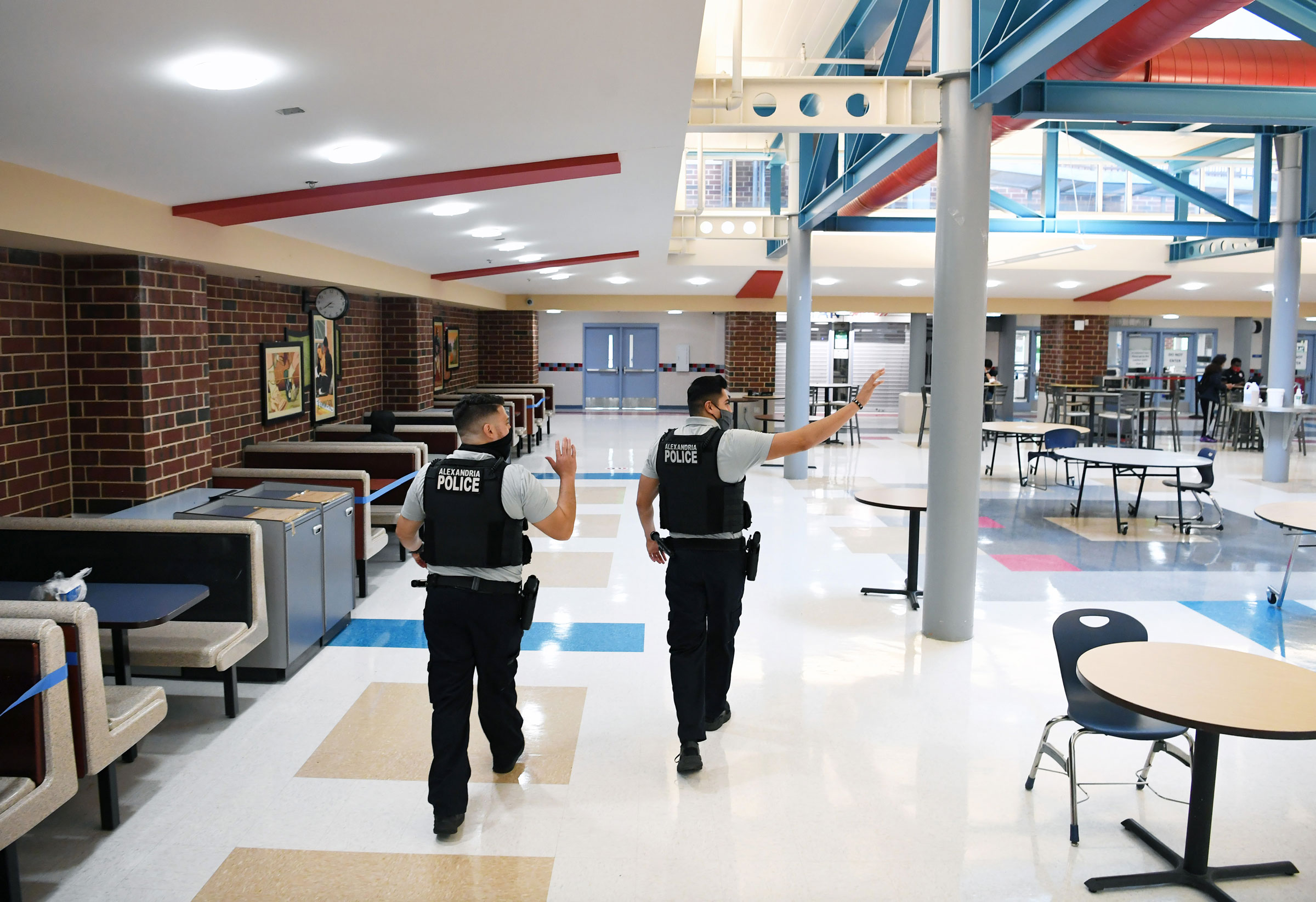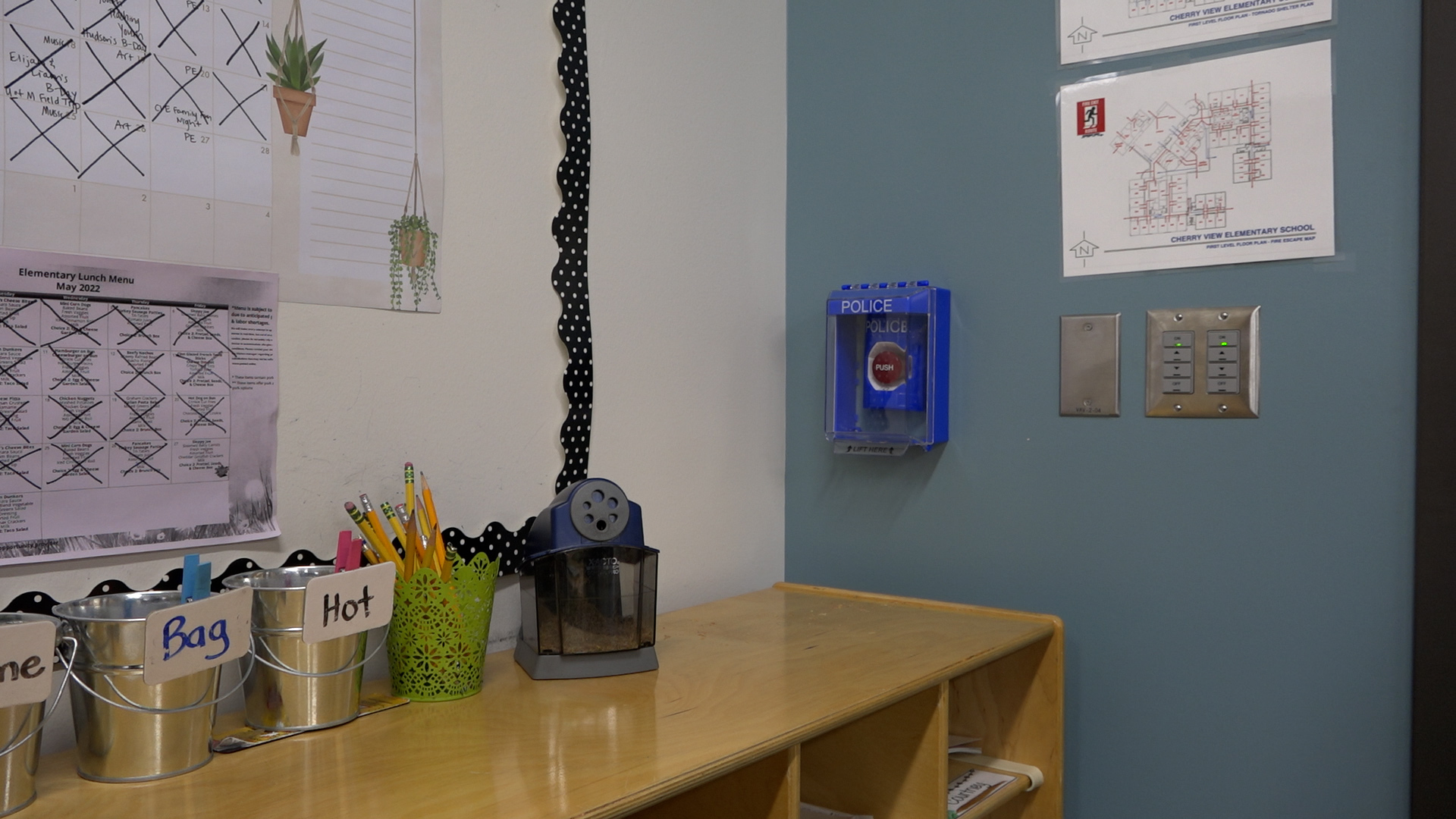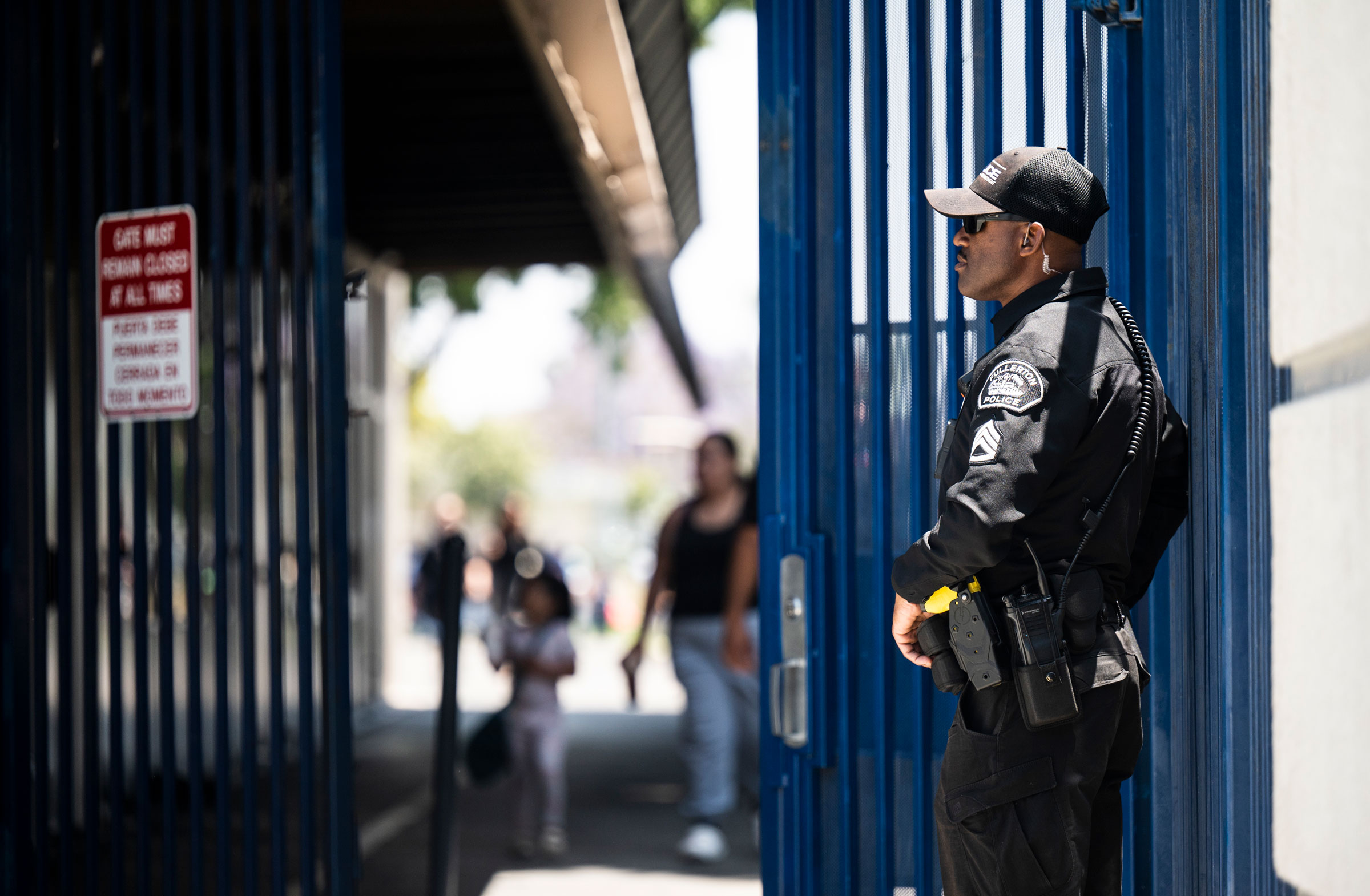
Beside pencil sharpeners and calendars documenting field trips and birthdays in classrooms throughout Minnesota’s Lakeville Area Schools, there are now big blue boxes with a red button and the word “POLICE.” The button sends a text message to emergency dispatchers, alerts the rest of the school to potential danger, and activates 1,200 pounds of magnetic force to keep the class door shut.
It’s one of the measures that Michael Baumann has implemented to protect against school shootings since he became superintendent of the district 20 miles south of Minneapolis in 2017.
He hired four more counselors to improve access to mental health services, established a team to monitor potential threats of violence, and rolled out measures “hardening” schools in the district. He hired a company to install the emergency-alert system and build ballistic panels into walls intended to stop bullets and protect hiding students. All the steps were aimed at helping students and teachers survive an active shooter.
“Everybody goes to bed and thinks ‘That’ll never happen in my school district.’ Well, I can tell you as a superintendent, that’s the nightmare. That’s what keeps you up at night,” says Baumann, who served in the Army for 20 years, deploying to Iraq and Afghanistan, before working in education. “I felt like it was my obligation to do what I could.”
The suburban district of roughly 11,000 students spent $14.4 million on the security system, and voters passed a measure in 2019 allocating $4.27 million per year to be spent, in part, on hiring an additional school resource officer and a school psychologist tasked with identifying and responding to potential threats.

The approach has varied in school districts around the country, but fear of school shootings has turned school security into a booming industry. The market for school security equipment and services reached $2.7 billion in 2017, according to a report by the research firm Omdia. That was before the 2018 shooting at Marjory Stoneman Douglas High School in Parkland, Fla., increased the focus on security measures at schools.
The deadly shooting at Robb Elementary School in Uvalde, Texas on May 24 has reignited the discussion about whether safety measures at schools can deter or stop mass shootings. And many Republicans, after indicating that they’re not willing to support gun-safety legislation, have argued instead that heightened physical security measures, often called “school hardening,” are necessary to prevent future attacks.
“Harden schools. There should be one entrance in and one entrance out,” Texas Lt. Gov. Dan Patrick said on Fox News on May 26. “The most effective tool for keeping kids safe is armed law enforcement on the campus,” Texas Sen. Ted Cruz said on May 24.
Former President Donald Trump—who established a federal commission on gun safety after the Parkland shooting that largely avoided discussing guns and suggested that schools consider increasing security measures like steel doors with bullet-resistant windows—returned to the topic when he addressed the annual convention of the National Rifle Association in Houston days after the Uvalde shooting.
“Every building should have a single point of entry. There should be strong exterior fencing, metal detectors, and the use of new technology to make sure that no unauthorized individual can ever enter the school with a weapon,” he said.
But experts say it’s not clear that such measures actually make schools safer. The number of shootings with casualties at K-12 schools has increased since the 2012-13 school year, when there were 22 shootings, and reached 93 shootings in 2020-21, according to the National Center for Education Statistics.
And some research has shown that students and staff report higher levels of fear in schools with visible security measures. A 2013 study, for example, found that metal detectors and similar security measures in school were associated with a decrease in students reporting that they felt safe. A 2018 study found that greater use of security cameras inside a school was linked to lower perceptions of safety, equity, and support among students, concluding that cameras “may evoke feelings of being viewed as potential perpetrators who need surveillance.”
In addition, there isn’t clear evidence that school resource officers (SROs) improve safety. SROs were on the scene in Uvalde and in Parkland before the gunmen entered the schools, but failed to stop those shootings. And racial-justice advocates have long warned that the growing presence of armed officers in schools will worsen the school-to-prison pipeline for students of color and interfere with their education. A 2009 study found that schools with an SRO had fewer arrests for weapons or assault charges, but had more student arrests for disorderly conduct, “consistent with the belief that SROs contribute to criminalizing student behavior.”
“There isn’t much evidence suggesting that the type of security procedures that are being put into place have much of an impact in keeping kids safe,” says Bryan Warnick, an education professor at Ohio State University who has studied school discipline and school shootings.
“But when we start to layer one security procedure on top of another, when we add metal detectors, surveillance cameras, increased police presence, active-shooter drills, and we turn schools into this mix of fortresses and prisons—it can have some negative impacts,” Warnick says.
Ron Avi Astor, a professor of social welfare and an expert on school violence at the University of California, Los Angeles, is part of a group of researchers who recently published an eight-point plan for preventing school shootings. It calls for making school climates safer from bullying and harassment, improving mental health services, and curtailing access to firearms across the country. The group’s gun-safety recommendations include a ban on assault-style weapons, background checks on all gun purchases and laws that allow for the removal of firearms “when there is a clear threat of lethal violence.”
“If we want to prevent school shootings, in particular, you have to address the gun issue,” Astor says. “There’s just no way around it.”
The group argues that “school hardening” policies should be avoided “because these strategies carry substantial risk for negative outcomes,” arguing that the presence of additional law enforcement officers and increased security measures can undermine student learning and well-being.
Instead, the researchers advocated for programs that promote social-emotional learning to help students deal with negative emotions, encourage supportive teacher-student relationships, and create a cohesive school environment, which has been shown to minimize bullying and behavioral problems. “Although security measures are important, a focus on simply preparing for shootings is insufficient,” the group wrote. “Prevention entails more than security measures and begins long before a gunman comes to school.”
A recurring debate
The latest school shooting is looming over jury selection for the sentencing trial for Nikolas Cruz, who pleaded guilty to killing 17 people at Marjory Stoneman Douglas High School in 2018. Defense attorneys requested that jury selection be put on hold due to the “wave of emotion” surrounding the Uvalde shooting, arguing it threatens Cruz’s right to a fair trial because the shooting “opened old wounds” for the community in Broward County, Florida, where the trial is taking place. Jurors will decide wether Cruz should be executed.
The ongoing debate over school hardening measures also mirrors the conversation that followed the 2018 shooting in Parkland, Fla., which led to calls for heightened security and proposals for arming teachers.
After the 2018 shooting at Sante Fe High School, Texas allocated $100 million for schools to use on hardening measures, including metal detectors, bullet-resistant glass, and campus-wide active shooter alarm systems. The Uvalde Consolidated Independent School District received $69,000 through that grant in January 2020, the Texas Tribune reported. But that didn’t stop a gunman from entering Robb Elementary and killing 19 children and two teachers.
And the Uvalde shooting is the latest tragedy to contradict the idea that “good guys with guns” stop mass shootings. Police entered the school minutes after the gunman, but waited more than an hour to enter the classrooms where the shooter had barricaded himself.
Still, school resource officers have been a growing presence in schools over the last two decades—in part as a response to the frequency of school shootings. About 51% of public schools had a sworn law enforcement officer on campus during the 2017-18 school year, up from about 36% of schools in 2005-06, according to data from the National Center for Education Statistics.

After the Uvalde shooting, Texas Gov. Greg Abbott sent a letter to the Texas Education Agency that put the onus on educators, asking the agency to create additional rules ensuring schools are “held to heightened safety standards.” Abbott instructed districts to conduct weekly door inspections, ordered administrators to identify actions they can take to make campuses more secure before the new school year, and encouraged schools to increase the presence of law enforcement officers on campus.
It’s a sign that, just as the Parkland shooting drove demand for school security enhancements, the Uvalde shooting could have the same effect. A new gun-safety proposal, supported by a group of 10 Republicans and 10 Democrats in the Senate, includes investments in school safety measures, school violence prevention efforts, and training for students and staff.
“A lot of districts are calling us now,” says Jason Polinski, co-founder of 3D Response Systems, the Minnesota-based company that recently installed the security measures in Lakeville Area Schools.
Polinski, who thinks focusing on gun-safety legislation is “not productive in any way shape or form,” argues the physical security measures are worth trying to give students and teachers more tools to survive in the event of a shooting. “I think it’s possible to harden schools to minimize the loss of life,” he says.
Baumann knows that the ballistic panels and emergency buttons in his schools won’t prevent a shooting. But he hopes that if all other preventative measures fail, these tools could limit the number of casualties. “When somebody’s decided they’re going to shoot up a school, how are you protected against that threat?” he says. “If you’re in that situation, all other things have failed.”
He wanted to give students and staff a strategy that would be simple enough to follow even amid the stress of an active-shooter situation. And he says he took pains to make sure those additions didn’t drastically alter the school’s appearance or hinder the learning environment. “You would never know they’re there,” he says.
As districts like Baumann’s work to fortify schools, some worry that hardening schools ultimately makes educators responsible for finding complex, expensive solutions to the country’s broader gun violence epidemic.
“We burden students with this fear and anxiety of having all these security procedures. We ask teachers to sometimes carry firearms and become soldiers in this war zone. We asked schools to turn themselves upside down with trainings and new procedures,” Warnick, the Ohio State researcher, says.
“And all of this is because we lack the courage and strength to make the changes that will really matter. It’s a larger societal problem of easy access to firearms, of lack of access to mental health care.”
More Must-Reads from TIME
- Introducing the 2024 TIME100 Next
- The Reinvention of J.D. Vance
- How to Survive Election Season Without Losing Your Mind
- Welcome to the Golden Age of Scams
- Did the Pandemic Break Our Brains?
- The Many Lives of Jack Antonoff
- 33 True Crime Documentaries That Shaped the Genre
- Why Gut Health Issues Are More Common in Women
Write to Katie Reilly at Katie.Reilly@time.com